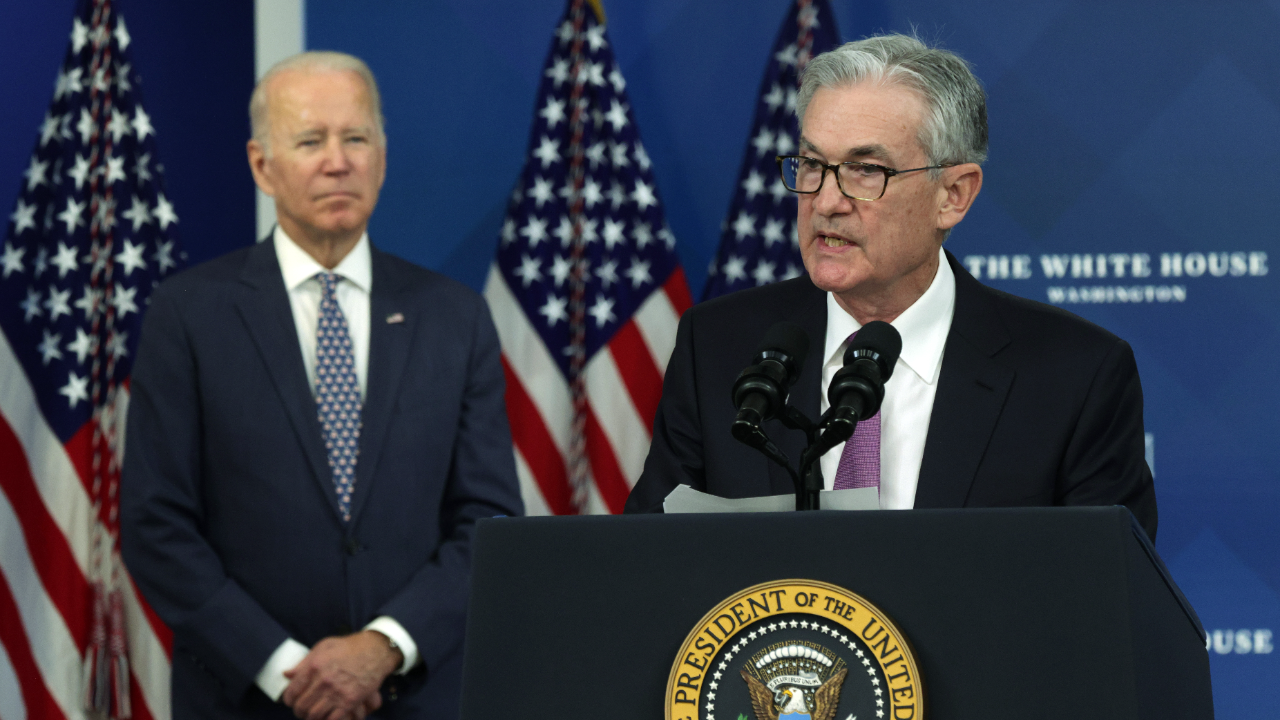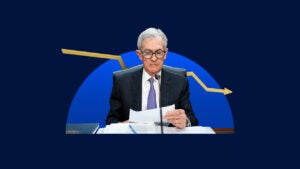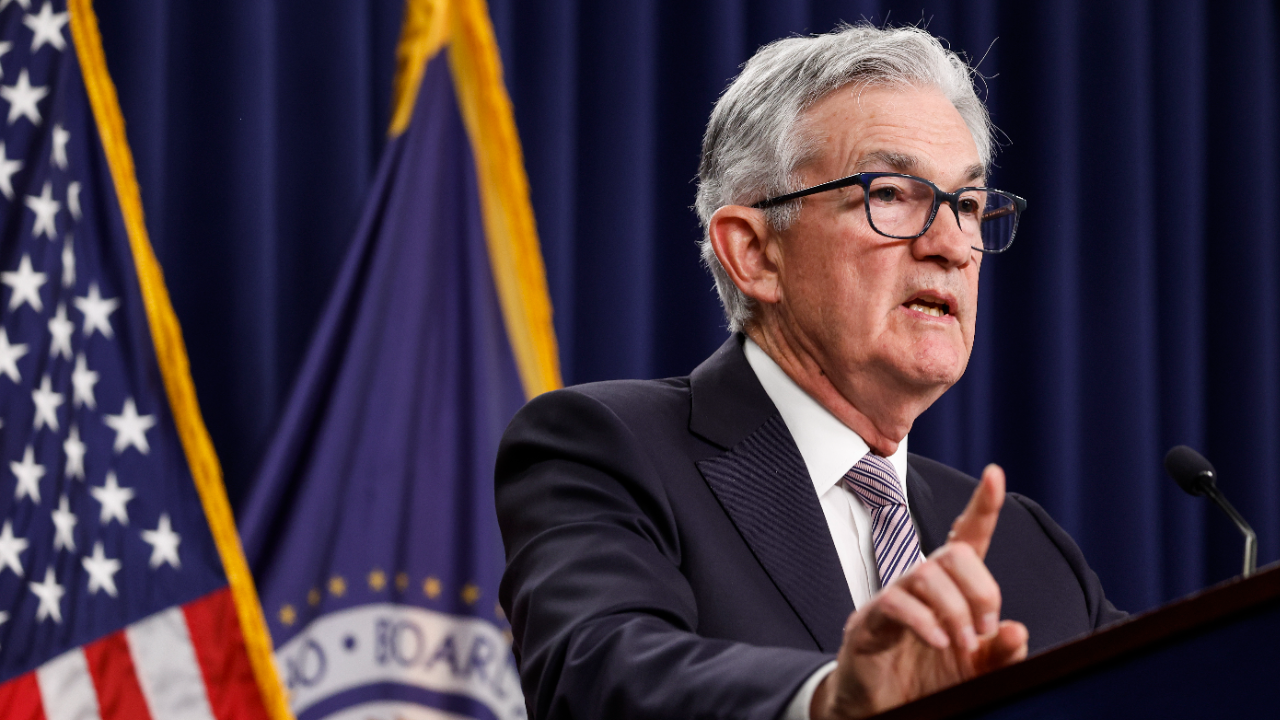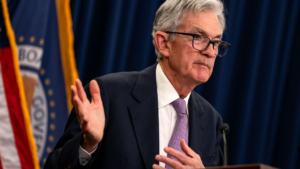Fed sees three rate hikes in 2022 and speeds up its taper of bond purchases

The Federal Reserve on Wednesday kept borrowing costs at near-zero percent but will now stop buying bonds three months earlier than initially planned, steps that will ultimately accelerate the end of economic stimulus and lay the groundwork for three possible rate hikes next year.
Beginning in January, the Fed announced that it will trim its monthly Treasury and mortgage-backed security purchases by a cumulative $30 billion a month, up from the $15 billion plan that officials set just last month. The new pace means the U.S. central bank will no longer be buying bonds by March 2022, rather than by June 2022.
- The Fed will reduce how many bonds it’s buying each month at twice the speed: $30 billion a month, versus the $15 billion originally announced in November.
- Fed pencils in three rate hikes for 2022 and three more for 2023.
- Officials scratch the phrase “transitory” when describing inflation, now saying price pressures have “exceeded” the Fed’s average 2 percent inflation target “for some time.”
What it means for: Mortgage rates | Savers | Borrowers | Investors
“Supply and demand imbalances related to the pandemic and the reopening of the economy have continued to contribute to elevated levels of inflation,” the Federal Open Market Committee (FOMC) said in a key change to its post-meeting statement, striking the phrase that recent rapid price gains are seen as “transitory.” “With inflation having exceeded 2 percent for some time, the committee expects it will be appropriate to maintain this target range until labor market conditions have reached levels consistent with the Committee’s assessments of maximum employment.”
The Fed propped up the U.S. economy in the aftermath of the coronavirus pandemic with ultra-low borrowing rates and massive asset purchases. The moves have helped keep the financial system awash with cheap credit during the worst recession in a lifetime. For consumers, that’s been most recognizable by some of the lowest mortgage rates in history.
Officials planned to keep aggressively supporting the economy as millions more Americans jumped back into the labor force and found employment again. Yet, consumer prices in 2021 have soared at the fastest pace in nearly 40 years, and the Fed’s preferred inflation tracker rose by the most since the 1990s.
Those price increases haven’t just sped up — contrary to what officials expected back in early 2021 — but have also broadened out to more categories than just the pandemic-impacted services and products. That’s made justifying the most aggressive easy-money policies in history an uphill battle for officials, who are now ushering in a new era for Fed policy as early as next spring that could mean more expensive borrowing costs and higher savings yields for consumers. No Fed official saw zero-rates persisting by 2022, with the median forecast among Fed officials calling for three rate increases in the year.
“The Fed retired the word ‘transitory’ from their statement and gave strong indications that they’re poised to hike interest rates once they deem the labor market to be at full employment,” says Greg McBride, CFA, Bankrate chief financial analyst. “Definitely a more hawkish tone, and the most we have seen in some time – similar to inflation.”
The Fed’s taper: What it means for you
Homeowners and would-be homebuyers
The bottom line is: Interest rate hikes, soaring inflation and a smaller bond-buying program are a recipe for higher mortgage rates in 2022. That might not mean much for homeowners with a fixed-rate mortgage, considering that the borrowing costs they pay are set for the entire life of their loan. But if you’re on the fence about refinancing or home buying, you might not have as much time on your side to lock in a good deal.
Meanwhile, homeowners with an adjustable-rate mortgage might want to get ahead of any rate hikes by refinancing into a fixed-rate loan. Even the mere expectation of a rate hike could lead to higher borrowing costs, with the 10-year Treasury rate climbing nearly 40 basis points in 2021.
Still, mortgage rates aren’t guaranteed to climb simply because the Fed is preparing to take its foot off the gas. Baked into the 10-year Treasury yield is investors’ expectations for where inflation will head. With the Fed preparing to back away faster, market participants might view it as a hawkish stance on inflation, causing yields to fall. Volatility in the 10-year Treasury market — which sets the pace for how much mortgage rates will rise and fall — has been a centerpiece of 2021. Even as inflation in November rose by the fastest pace in nearly 40 years, the 10-year yield has fallen about 20 basis points from its high.
Another question mark: How tighter Fed policy could impact Americans’ home equity in 2022. Homeowners have amassed a record $25.32 trillion in equity as of the third quarter of 2021, according to Fed data. If someone has equity in their home, it means their home is worth more than the outstanding balance of their mortgage — and many homeowners (albeit, those with crystal-clear records) can tap into that balance, either with a cash-out refinance, a home equity loan or a home equity line of credit (HELOC). Rising rates, however, could squeeze that equity, particularly if housing values also cool in 2022 after a record year.
“Increasing mortgage rates alongside continued price growth results in reduced affordability, and that might cause house prices to moderate a little bit,” says Odeta Kushi, chief economist at First American Financial Corporation. “The people struggling are the first-time homebuyers, who are trying to buy a home in an environment of historically high prices, potentially rising mortgage rates and very limited inventory.”
Savers
Until the Fed hikes interest rates, the yield that you receive for stashing away your cash in savings accounts or certificates of deposit (CDs) is bound to hold at record lows. Those rates tend to move in tandem with the Fed’s short-term benchmark interest rate, the federal funds rate.
Americans, however, shoveled a historic amount of cash away into their bank accounts during the pandemic, weighing on banks’ offerings even more. Those savings rates have started to dwindle in recent months, as consumers leave their homes again and use up their remaining stimulus cash, either from direct stimulus checks or expanded unemployment benefits. All of that means rates could start to modestly increase in 2022, absent of a Fed liftoff.
Consumers, however, can still find ways to earn 10 times the national average yield by moving their money from a traditional brick-and-mortar bank to an online high-yield savings account.
Borrowers
Consumers will want to concentrate on paying any overhanging balances off before rates increase, especially if they have high-cost credit card debt. That’s because your borrowing costs will only get more expensive after a Fed rate hike. The prime rate, which is what credit card companies use to set their annual percentage rates (APRs) on top of a margin, directly tracks the fed funds rate.
If you will have trouble paying off that balance within the next year, analyze how much you would save in interest by estimating the cost of transferring your debt to a balance-transfer card or debt consolidation loan.
Investors
Investors will want to look for any volatility as the Fed normalizes its policy following more than two years of its most stimulative stance yet — but don’t make any knee-jerk reactions. Better yet, see any market downdraft as a potential buying opportunity.
While easy money policies bode well for stocks, higher inflation could be the biggest boogeyman in the market if it becomes too entrenched. Experts recommend bracing for higher prices by managing a diversified portfolio with traditionally inflation-safe investments, from dividend-paying stocks and preferred stocks to real estate investment trusts. Meanwhile, avoid leaving too much cash in fixed-income investments, such as bonds, which tend to be more sensitive to price increases.
With higher rates in sight, officials keep an eye on economic backdrop
The Fed’s faster end to stimulus helps officials ensure that policy is well-positioned for any scenario, whether inflation ends up settling back down, holding higher for longer — or whether the U.S. economy takes a turn.
Officials have already broadcast that they don’t want to touch interest rates while they’re still buying bonds. They also don’t want to risk keeping millions more out of work by hiking interest rates too fast. Yet, wrapping up the Fed’s bond-buying will allow officials the flexibility to hike interest rates, should it be necessary to prevent the economy from overheating.
Job market
Fed officials are bound to let labor market and inflation data speak for themselves, but both are telling mixed messages.
By some measures, the job market has recovered faster than officials had ever expected back when nationwide lockdowns knocked the financial system into a recession. Unemployment has now fallen to 4.2 percent, just 70 basis points from the 50-year lows that prevailed before the pandemic. Officials see unemployment reaching the pre-pandemic level of 3.5 percent by 2022.
Yet just 83 percent of the 22.4 million job losses during the worst of the pandemic have been recovered, while some 2.3 million more workers are still missing from the labor force. The recovery also hasn’t been felt equally, with Black unemployment around 3 percentage points higher than White joblessness.
Inflation
Fed officials have wanted to keep rates low to guide the labor market toward an inclusive recovery, but high inflation is challenging that goal. So far throughout 2021, consumer prices have soared 6.35 percent and increased a whopping 6.9 percent between now and this time last year, the fastest rate since 1982.
Fed Chair Jerome Powell implied during a post-meeting press conference that the Fed might no longer be so patient to let participation recover — and that price stability will be another key driver that steers the economy back to full employment.
“We have to make policy now, and inflation is well above target.” Powell said. “If we knew [labor force participation] would start to move up in two years, would we wait two years when inflation is running way above target? Probably not. What is the level of maximum employment that is consistent with price stability in real time, is one way to think about it.”
Consumer prices tend to increase at faster clips than the Fed’s preferred measure of inflation, the personal consumption expenditures (PCE) index. Even that gauge, however, is flashing red-hot warning signs. So far this year, the gauge has soared by 4.3 percent, already eclipsing the level that Fed officials back in September had expected it to reach by the end of this year.
Omicron variant
Another wrinkle is the Omicron variant, which risks keeping jittery workers out of a job for longer. Many Americans cite virus-related fears as a reason for not working. The Omicron variant, however, could also put upward pressure on inflation, especially if it exacerbates the supply-chain disruptions that have already sent consumer prices soaring.
“The Omicron variant is a wild card for both Fed policy and the overall economy,” McBride says. “Until there is greater clarity about transmissibility and possible economic fallout, the Fed has left themselves room to reverse course should it become necessary.”
Fed officials see elevated inflation persisting through at least 2024, with the PCE index ending 2021 at 5.3 percent, though moderating down to 2.6 percent at the end of 2022.
Illustrating the speed of the recovery, Fed officials also see the U.S. economy growing by 5.5 percent in 2021 and 4 percent in 2022. Ending the bond-buying program early also reflects their perception of the strength of the U.S. economic recovery.
“The economy is so much stronger now,” Powell said. “The economy no longer needs increasing amounts of policy support.”
Biden still has three seats to fill on Fed’s board of governors
Juggling the Fed’s twin goals will be the biggest task for policymakers in 2022. Removing a layer of uncertainty is President Joe Biden’s decision to renominate Jerome Powell to a second term as chair. The chief executive also appointed Fed Gov. Lael Brainard to be the Fed’s vice chair, the second-in-command at the U.S. central bank.
Biden still, however, has three open roles at the Fed, vacancies for which he plans to fill before the holidays, according to Biden administration officials. That’s even more of a reason to expect that Fed policy next year isn’t yet set in stone, especially if the administration ends up appointing officials who are much more dovish than the current committee.
The Fed’s outgoing members — Vice Chair Richard Clarida and Vice Chair for Supervision Randy Quarles — were appointed by President Donald Trump and have been vocal about it being time to start tapering stimulus.
All of that also points to how important messaging will be as the Fed moves ahead with a new regime in 2022 — though the uncertainty of the economy will make that a tall task.
“When conditions change, you should change your view, and they have,” says David Berson, senior vice president and chief economist at Nationwide, and a former Treasury Department analyst. “The Fed will try to give notice to markets about how they’re thinking, but if conditions change rapidly, then they may not be able to do that. There may very well be times in the next year or two when the Fed has to make policy decisions that are not well-telegraphed.”






